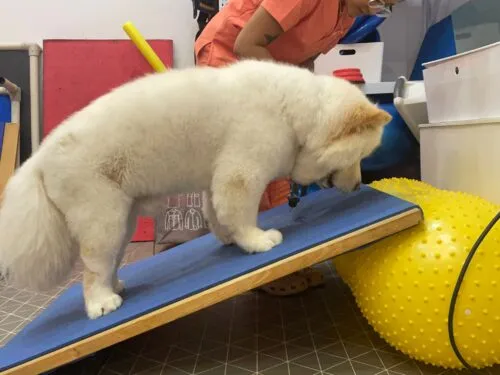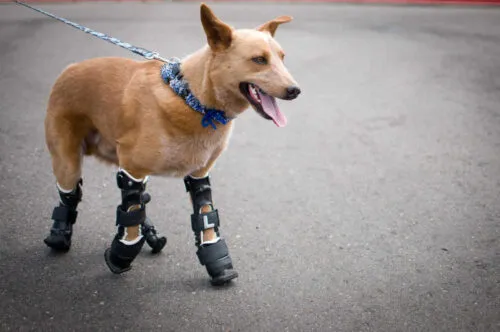EXCELLENTTrustindex verifies that the original source of the review is Google. Shout-out to the dedicated team for their attentiveness and patience. Today is Kobi's 3rd hydrotherapy sessions, and am happy to see that he's taking well to it, albeit the slight hesitation (and nervousness) in the beginning. Keeping my fingers crossed that the sessions will help improve and maintain his mobility/fitness and attain a healthy weight 😊Trustindex verifies that the original source of the review is Google. My dog Barley hind leg limping for months. Saw vets and said arthritis. Treated with pain killers but no improvement. My dog has heart failure and medications made her conditions worsen. I googled it to find dog acupuncture services and found Rehabvet. Underwent for assessment and started laser treatment for pain. I noted my dog felt better straight away and I signed up for rehab package. Rehabvet team is very caring and well experience in rehabilitation of dogs. I recommend Rehabvet services for dogs owners who need rehabilitation or pain management of their dogs.Trustindex verifies that the original source of the review is Google. TDLR: Saw alot of improvement on my dogs weak legs in just 10x 1-hour sessions, defo worth every penny imo. My dog came in with a very common issue of hip dys + luxating patella and as an owner, i've already exhausted majority of the options out there, including visiting a ortho specialist. As I'm against the idea of any invasive surgery, i decided to give rehab a try first. throughout all 10 sessions, i never ever felt rushed even on days when i had more questions or when her sessions exceeded the 1 hour mark/ the hour they're closing. despite the many pets that they go through in a day, i always felt they were genuine and never saw clients as their 'moneypot'. As my dog is reactive towards other pets, the staff never fail to accommodate and try to find me a room for us to wait in. All in all, i can say that my dog's posture when standing is alot better, hind legs are alot stronger than before, also limps alot lesser right now. but at the same time, owner also has to put in the effort and walk/ exercise on the other days of the week. this is no miracle work if you don't play your part 🤣 All the staff are always so gentle when handling her, she would have definitely slept during the sessions if she wasn't an anxious doggy.Trustindex verifies that the original source of the review is Google. Mantou started his rehab journey with random trembling in his hind legs. Through the sessions, we understood the root cause of the issue and how it affected him as a whole. We started on a treatment plan to heal and strengthen Mantou's muscles. Apart from getting lots of sayangs, treats, and massages, Mantou also gained confidence in swimming during his sessions. Both the hoomum and Mantou learned and practiced exercises that are beneficial to Mantou's condition and help strengthen what was lacking. We walked away not only with a stronger and more well-built Mantou but also with the knowledge to maintain and continue his progress. 10/10 would recommend the team at Rehab Vet for their dedication and care!Trustindex verifies that the original source of the review is Google. Having been to several vets and rehabs with my senior Shih Tzu, my experience at RehabVet has been the best. My only regret was not bringing him here sooner when his issues first came up! My very anxious 15 year old kiddo was diagnosed with IVDD and is unable to move all his limbs voluntarily at all times. It was a very sudden event and both of us were under lots of stress. We WhatsApp-ed the team and got an appointment promptly. After the initial testing and diagnosis by Dr. Sara, he has had a few trips to the Hyperbaric O2 Therapy, Laser Therapy, and Electrical Stimulation with massages. Now, I can tell that he is in less pain and is also more comfortable and less anxious. Xan always handles him with so much care so I feel very assured when I leave my kiddo with him and the specialists there. He also takes the time to teach me how to perform home therapy. I can see and feel that Dr. Sara, Xan, and the team there truly cares about helping each and every doggy (or kitty)! I would highly recommend RehabVet to anyone thinking about it!Trustindex verifies that the original source of the review is Google. We are truly thankful for what Rehabvet has done for many of our shelter dogs - hock Lai (spinal injury and FHO on left leg), nugget (patella luxation and hunch back, weakness on both hind and in a lot of pain), Eden (ACL injury), keeper (arthritis), jay jay (arthritis) and more. They never fail to amaze us with the results. When we lose hope, miracle appears! They treat singapore special the same way they treat other dogs. No prejudice and totally invested to see them improve every session. Thank u Dr Sara, Angeline, Joyce and everyone involved !Trustindex verifies that the original source of the review is Google. very patient and knowledgeable staffsTrustindex verifies that the original source of the review is Google. We’ve been with the Rehab Vet team for nearly half a year now, and they’ve been absolutely amazing. The team is not only knowledgeable but also incredibly kind and accommodating. Both my Singapore Specials have been so well cared for, even though only one of them requires the service. Their genuine dedication and warmth have made every visit a positive experience. Thank you for all that you do, and keep up the fantastic work, team!Trustindex verifies that the original source of the review is Google. I can't thank Xan and his team at RehabVet enough for the incredible care they've given my dog. After a sudden incident where my dog started dragging both hind legs, the vet diagnosed him with IVDD stage 2. The animal hospital quoted me a huge amount for a CT scan and surgery, and I wasn't sure if I wanted to put my senior dog through that. I decided to try physio at RehabVet, and it was the best decision I could have made. Within just 2-3 sessions, my dog's hind legs showed significant improvement—they were no longer wobbly. Now, after 7-8 sessions, he's regained his mobility and is even jumping around at home again. Xan's patience and dedication made all the difference. He provided thorough treatment during each session, and my usually anti-social dog felt comfortable and happy around him. Unlike other experiences I've had, Xan always gives my dog his full attention and care, making sure each session is truly effective. Every session I just leave my dog with him and can have some me time while trusting that my dog is in good hands. They even send me pictures of my dog during the treatment to keep me updated and provide specific instructions on exercises I can do with my dog at home until the next session. I highly recommend RehabVet to anyone in need of compassionate, effective care for their pet. 👍🏻👍🏻👍🏻Verified by TrustindexTrustindex verified badge is the Universal Symbol of Trust. Only the greatest companies can get the verified badge who has a review score above 4.5, based on customer reviews over the past 12 months. Read more
Dog physiotherapy is a specialised treatment approach that focuses on:
Addressing musculoskeletal issues: Targeting joint, muscle, and tendon problems, including injuries, degenerative conditions, and post-operative care.
Improving mobility: Enhancing strength, flexibility, and range of motion through tailored therapeutic exercises and interventions.
Pain relief: Utilising non-invasive techniques like massage, joint mobilisation, and therapeutic modalities to alleviate pain and discomfort.
Individualised care: Designing custom treatment plans that consider each dog’s unique needs and goals.
Supporting recovery: Promoting optimal healing and restoring functionality after injury, surgery, or illness.
At RehabVet Clinic, our expert team delivers exceptional physiotherapy services, improving your dog’s quality of life and well-being.
Dog physiotherapy involves a combination of techniques and exercises, including massage therapy, manual therapy, laser therapy, and therapeutic exercises. These techniques are designed to improve muscle strength, flexibility, and range of motion, as well as reduce inflammation and pain.
This therapy is particularly effective for dogs recovering from surgery, suffering from arthritis, or experiencing mobility issues due to aging or injury. It is a non-invasive and drug-free approach to treating mobility issues in dogs, making it a safe and effective treatment option.


Here are some of the benefits of dog physiotherapy:
Reduced pain and discomfort: Dog physiotherapy can help reduce pain and discomfort associated with injuries, chronic conditions, or post-surgery. This is achieved through various techniques such as massage, joint mobilisation, and heat therapy.
Improved mobility and range of motion: Physiotherapy can help improve a dog’s mobility and range of motion. This is particularly important for dogs with joint conditions such as arthritis or after surgery. The therapy can help loosen up stiff joints and improve muscle strength, enabling the dog to move more freely.
Faster recovery from injuries or surgeries: Dog physiotherapy can also help dogs recover faster from injuries or surgeries. By improving blood flow, reducing inflammation, and providing targeted exercise, physiotherapy can help speed up the healing process.
Better quality of life: Dogs that undergo physiotherapy often experience an improvement in their overall quality of life. They may have less pain, be more mobile, and be able to engage in activities they enjoy.
Non-invasive: One of the biggest advantages of dog physiotherapy is that it is non-invasive. Unlike surgery or medication, physiotherapy does not involve any invasive procedures or drugs, making it a safe and natural form of treatment for dogs.
Dog physiotherapy can be used to treat a wide range of conditions in dogs. Some of the most common conditions that can benefit from physiotherapy include:
Arthritis: Dog physiotherapy can help alleviate the symptoms of arthritis by reducing inflammation, improving mobility, and increasing muscle strength.
Back pain: Physiotherapy can help relieve back pain in dogs by using techniques such as massage, heat therapy, and specialised exercises.
Post-surgical rehabilitation: Dog physiotherapy can help dogs recover more quickly from surgery by reducing pain and inflammation, and by providing targeted exercises to improve mobility and range of motion.
Neurological conditions: Physiotherapy can be used to treat dogs with neurological conditions such as spinal cord injuries or paralysis. The therapy can help improve coordination, balance, and muscle strength.
Sports injuries: Dogs that participate in sports or other physical activities can benefit from physiotherapy to prevent and treat injuries.


Below are some of the most commonly used techniques and exercises in dog physiotherapy:
Massage Therapy: Massage therapy involves the manipulation of soft tissues, including muscles, tendons, and ligaments, to relieve tension, reduce pain, and promote relaxation. It can also help to increase circulation, which can speed up the healing process.
Stretching Exercises: Stretching exercises can help to improve flexibility, increase range of motion, and prevent muscle stiffness. These exercises can be tailored to specific areas of concern, such as the neck, back, or limbs.
Hydrotherapy: Hydrotherapy involves using water to help facilitate movement and exercise. This can be particularly useful for dogs with mobility issues, as the buoyancy of water can help to reduce stress on the joints and muscles.
Electrotherapy: Electrotherapy involves the use of electrical stimulation to help stimulate muscles, reduce pain, and improve circulation. This technique can be particularly useful for dogs recovering from surgery or suffering from chronic pain.
Therapeutic Exercises: Therapeutic exercises involve performing specific movements and activities tailored to the needs of the individual dog, which help improve strength, flexibility, and mobility.
At RehabVet, we specialise in providing animal physiotherapy to pets of all shapes and sizes. Our team of experienced and qualified therapists use a variety of techniques and exercises to create personalised treatment plans for each animal to ensure optimal results.
Our services include:
1. Assessment: Our initial assessment involves a thorough examination of your pet to determine the underlying condition or injury that is causing their mobility issues. We also take into consideration their medical history, lifestyle, and any other relevant factors.
2. Treatment: Once we have identified the cause of your pet’s mobility issues, we will create a personalised treatment plan that utilizes a combination of techniques and exercises to address their specific needs. Our treatments may include massage therapy, manual therapy, laser therapy, and therapeutic exercises.
3. Follow-up: We will schedule regular follow-up appointments to monitor your pet’s progress and adjust their treatment plan as necessary. Our goal is to help your pet achieve maximum mobility and improve their overall quality of life.
Overall, animal physiotherapy can be a highly effective treatment option for pets suffering from a wide range of conditions. At RehabVet, we are committed to providing top-quality care to all of our furry patients. If you believe that your pet could benefit from animal physiotherapy, contact us today to schedule an assessment.
